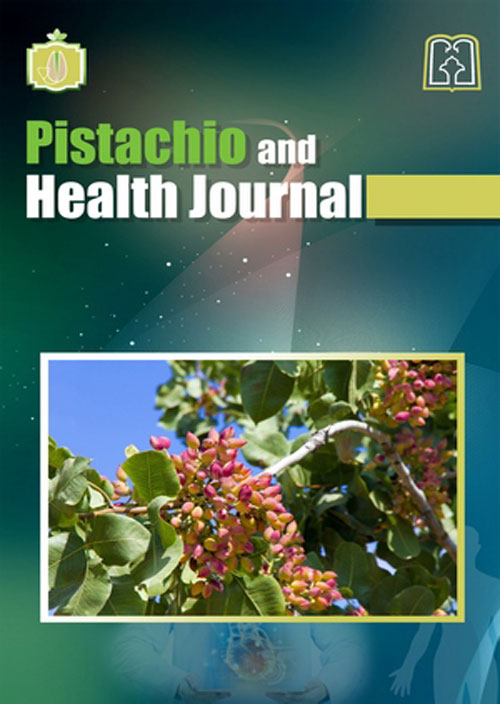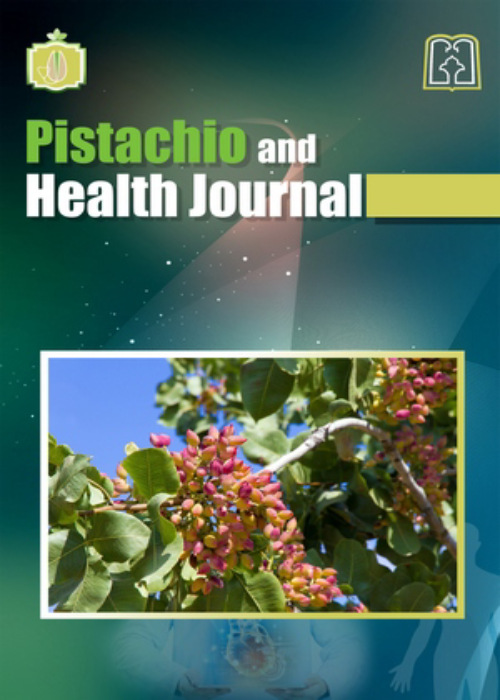فهرست مطالب

Pistachio and Health Journal
Volume:3 Issue: 1, Winter 2020
- تاریخ انتشار: 1398/11/12
- تعداد عناوین: 7
-
-
Pages 1-5
The economic status of pistachios, apart from their nutritional value, has attracted the attention of researchers. Pistachio storage conditions, being the subject of the current research, have been studied by researchers. Pistachios are usually stored for a short or long period of time before distributed to the market. Therefore, suitable storage conditions are essential for pistachio health and quality. Accordingly, employing novel storage methods can lead to more nutritional benefits in fresh pistachios.
Keywords: Pistachio health, Pistachio Storage, Quality Change -
Pages 6-17Introduction
Hypertension, as a risk factor for cardiovascular diseases, is highly influenced by dietary parameters. This study aims to investigate the possible association of hypertension prevalence and nut consumption.
Materials and MethodsIn this cross-sectional study, 9990 participants from the Rafsanjan cohort study, as a part of the prospective epidemiological research studies in IrAN (PERSIAN), aged 35-70 years were included. Nut consumption was assessed using an abbreviated food questionnaire. Further, demography, personal habit, physical activity, medical history, blood pressure, and body mass index (BMI) questionnaires were used. Logistic regression models were applied to examine the possible relationship between hypertension risk and nut consumption. Statistical analyses were performed using STATA statistical software.
ResultsThe results showed that the average consumption of all nuts except walnuts was significantly higher in non-hypertensive individuals (P<0.001). In the crude regression model, the odds of hypertension were significantly lower among pistachio, walnuts, seeds, and total nuts consumers. However, a protective association was observed between the prevalence of hypertension and the consumption of all nuts together and seeds, after adjusting for sex, age, and other confounders.
ConclusionThe data show that the intake of all nuts and seeds is inversely associated with hypertension risk.
Keywords: Nut, Hypertension, Prospective Epidemiological Research Studies in IrAN (PERSIAN) -
Pages 18-31Introduction
One of the most popular nuts in Iran is Pistachio (Pistachia vera L.). This nut is used as a food additive due to its high and uniquenutritional properties. Postharvest operations such as handling, cleaning, packaging and storing conditions have considerable effects on sensory attributes, the nutraceutical benefits, and shelf-life. Therefore, this research aims to predict the EMC of ground pistachio nut (GPN) undergoing 20oC storage based on two key criteria [i.e. T and ERH= (aw×100)] and application of the intelligent system of fuzzy logic.
Materials and MethodsThe fuzzy logic model (FLM) was used to foresee of the EMCs (ads. /des.) behavior of GPN. First, the data obtained for EMC were run in MATLAB software & the fuzzy logic package was applied for EMC modeling of GPN. The variables were divided into two groups: inlet including storage temperature and water activity (aw) and outlet is EMCs. Next, effective verbal variables were defined for both dependent and independent variables.
ResultsThe FLM could predict EMCs (ads. /des.) of GPN with an R 2 value equal to 0.9959 and 0.9869, respectively
ConclusionsTotally, the obtained results of present study are operational by workstations of GPN producer & theirplants to control the shelflife.
Keywords: Fuzzy logic, Sorption isotherm, Modeling, prediction, Ground Pistachio Nut -
Pages 32-44
The most common method of dealing with the pathogens is applying disinfectants. Thus far, a wide range of disinfectants and antiseptics has been introduced to the food industry and different centers. Latest studies highlight the application of nanoparticles and other novel compounds. The present work is a review article on applying new chemical disinfectants in the food industry. It reviews the papers published indifferent scientific databases. To conduct the present study, the keywords, such as disinfectant, antiseptic, bactericide, bacteriostatic, antibacterials, microbicides, and biocides, are searched at different databases, including Web of Science, SCOPUS, PubMed, Science Direct, and Google Scholar. Totally, 600 articles on new materials and their disinfectant application are selected from 2009-2018.Among the selected papers, 477 were about applying compounds such as silver/its nanoparticles, complexes, zinc oxide/its nanoparticles, titanium dioxide, and electrolyzed water (EOW).Reviewing different articles on the new disinfectants, it is concluded that the recent studies mainly focus on the application of nanoparticles, complexes, and innovative physiochemical methods, including electrolysis in producing applied disinfectants in the food industry (e.g., pistachio industry). Among the above items, the EOW disinfectant, more commonly used in the food industry, seems to have the least complications for the environment and people’s health. However, given this disinfectant novelty, it is required to conduct more studies on its toxicity.
Keywords: Disinfectant, Antiseptic, novel methods, Food Industry, Pistachio Processing -
Pages 45-57Introduction
Pistachio soft hulls contain tannins that are polyphenolic compounds with some antinutritional effects. This research aims to isolate and characterize tannin-degrading bacteria from goat feces consuming soft pistachio hulls as a TRD (tannin rich diet) with high potential application in tannin biodegradation.
Materials and MethodsEnrichment culture was used in minimal media containing tannin to isolate degrading bacteria. The isolates were identified by morphological, biochemical, and molecular characterization. In addition, tannase production, the maximum tolerable concentration (MTC), pH, and the tannic acid amount of the media were determined during degradation.
ResultsFour strains with tannin-degrading ability were isolated from feces of goat before (TA1) and after (TA2-4) consuming the TRD. In addition, 16S rDNA gene sequenceing, assigned TA1 and TA3 isolates to the genus Pseudomonas (ATTA 34), and TA2 to the genus Pantoea (ATTA33), and submitted to the GenBank (accession numbers KJ783441 and KJ783440). The isolates showed the MTC of 32 and 64g/L. The degradation percentage reached a maximum of more than 95% after 72h in the presence of 15g/L tannin. The pH as well as tannin utilization decreased except in the case of TA2, in which it increased again after 48h, which could be related to the gallate decarboxylase activity.
ConclusionThe TRD was able to induce adaptive responses. Although the bacteria were capable to detoxify and degrade the tannins, they needed to adapt to high concentrations of them (up to 64g/L). This study is the first report of Pantoa stewartii subsp indologenes with both tannase and gallate decarboxylase activities. These isolates possess wonderful potential for utilization in bioremediation, also minimization of tannins antinutritional effects in animal diets.
Keywords: Biodegradation, Gallate Decarboxylase, Pantoea, Pistachio Soft Hulls, Pseudomonas, Tannic Acid -
Pages 58-75Introduction
In recent decades, antibiotics have received much attention as emerging contaminants in aqueous environments. Tetracycline is one of the most widely used antibiotics all over the world and has been detected in aqueous environments at high concentrations. Antibiotic residues in aqueous environments may have toxic and adverse effects on the biological balance of aquatic ecosystems, leading to antibiotic resistance in microorganisms. Therefore, the treatment and removal of these pollutants from aqueous environments are essential.
Materials and MethodsIn this study, tetracycline antibiotic was removed using activated carbon prepared from hard pistachio shell as adsorbent in this treatment process, and the effect of various variables such as initial antibiotic concentration, solution pH, adsorbent level, and reaction time were investigated. The analysis of adsorption kinetics, isotherms, and the structural properties of the adsorbent was performed using scanning electron microscopy (SEM) and isoelectric point of zero charge (pHpzc).
ResultsThe results showed that maximum efficiency of antibiotic removal under optimum conditions at the initial concentration of 20 mg/L, pH of 5, adsorbent level of 0.35 mg/L, and reaction time of 45 minutes was equal to 99.8%. The adsorption process of tetracycline antibiotics follows second-order kinetic model (R2= 0.9973) and Langmuir isotherm (R2= 0.995).
ConclusionThis study showed that the adsorption process using activated carbon prepared from hard pistachio shell has high efficiency in terms of the removal of tetracycline antibiotics and can be used as an adsorbent to replace expensive adsorbents.
Keywords: Tetracycline, Adsorption, Activated carbon, Hard Pistachio Shell, Aqueous solutions -
Pages 76-86Introduction
Bene, i.e. wild pistachio (pistacia atlantica), is considered one of the natural resources in Iran. The production potential of this product is so high that upon identifying it, it will be possible to produce a large amount of edible oil annually. In addition, it is well comparable with other oilseeds in terms of the oil content, so it could have a high position among edible oils.
Materials and MethodsIn this study, some physicochemical properties of oil from whole wild pistachios, including oil percentage, fatty acid profile, thermal stability (by the Rancimat method), and the refractive index were evaluated. The samples were prepared randomly from domestic supply centers of the counties of Baft, Jiroft, and Shahr-e Babak in September 2017, and oil from three kilograms of each sample was extracted using the cold press method.
ResultsAccording to the results, the rate of oil extraction from whole wild pistachios varied from 27.5 to 28.5%, with unsaturated fatty acids having formed 83% of which. In addition, oleic acid was the predominant fatty acid with 52 to 54%, with the highest amount of which having been observed in the sample of the Baft County. The results of thermal stability and the refractive index were evaluated to be similar in the three oil samples. Based on the results, there was no statistically significant difference in thermal stability and the refractive index among the samples (P≥ 0.05).
ConclusionThe investigation of the fatty acid profile of wild pistachio oil showed that it is one of the most valuable oils in terms of the oleic acid content, being almost close to olive oil in this respect. Given the higher level of monounsaturated fatty acids (especially oleic acid) than its polyunsaturated counterparts, such as linoleic and linolenic acids, wild pistachio oil has suitable thermal stability.
Keywords: Wild Pistachio Oil, Fatty acid profile, Gas Chromatography, Oxidative stability


